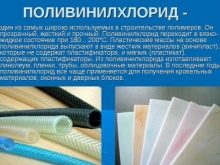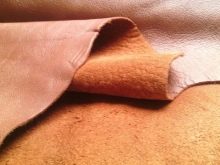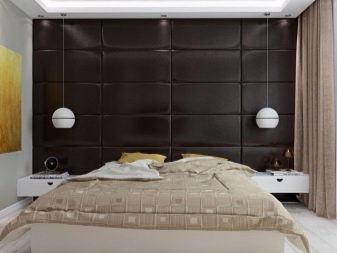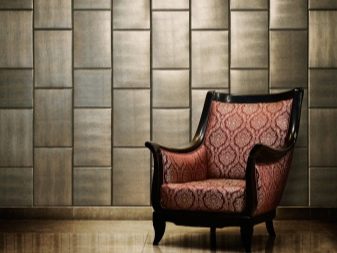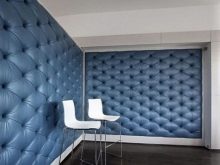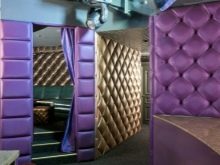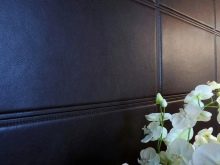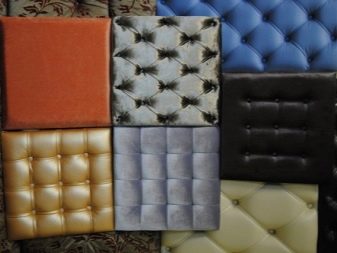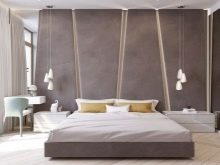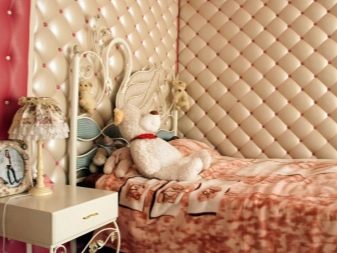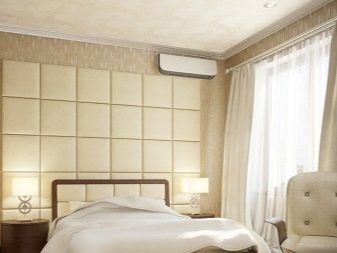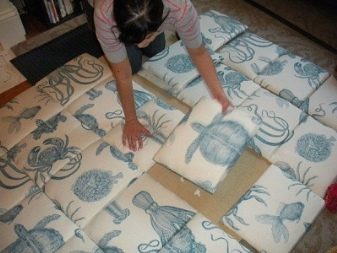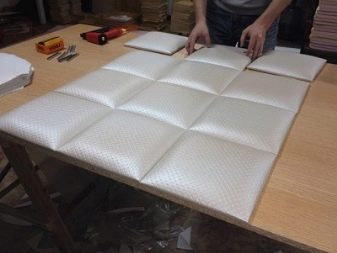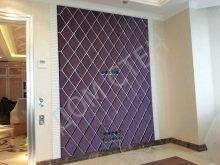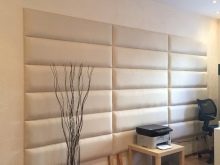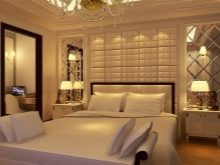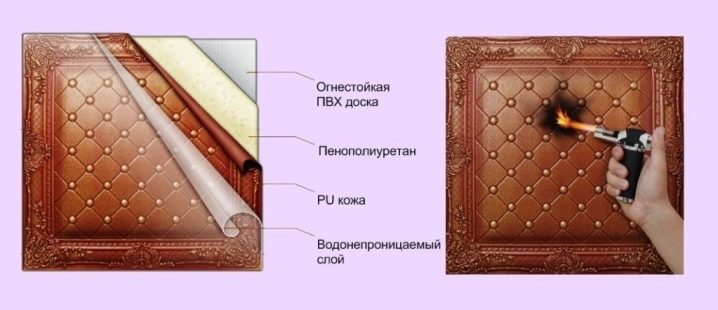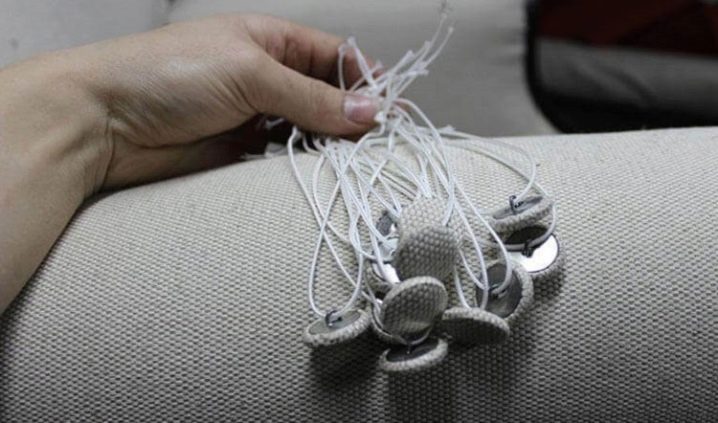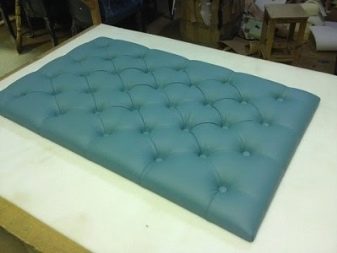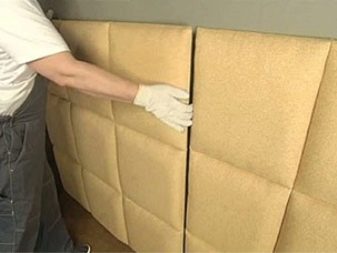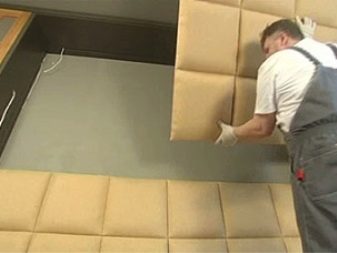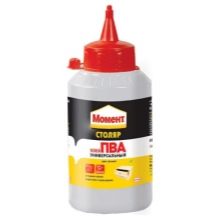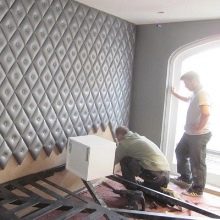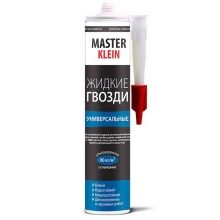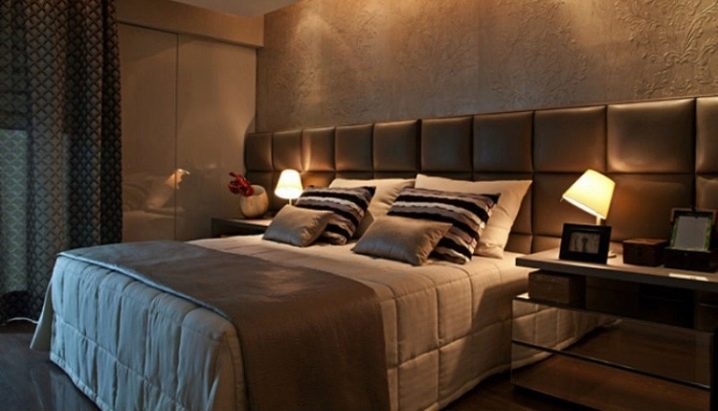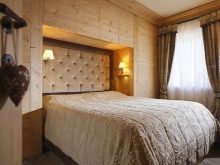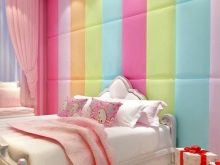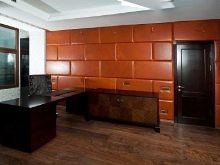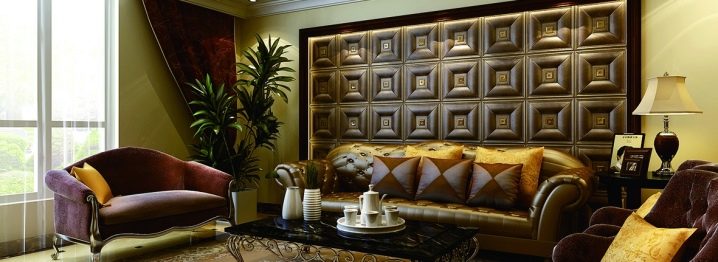Soft wall panels: design options and installation methods
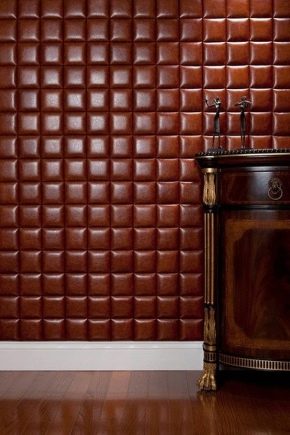
Soft wall panels have a special elegance and charm among the variety of finishing options. They can be met infrequently, however, such an interior always looks unusual. The material allows you to emphasize individuality, to focus on one of the walls, to bring the atmosphere of elegant luxury into the room.
Special features
Soft wall panels are designed for interior decoration. This is a voluminous material, characterized by texture, original appearance. As a rule, there are products, the production of which is conducted in the factory, although they can be made with your own hands.
The panels consist of several layers and have the following device:
- the foundation made of durable sheet materials with good adhesion, for example, polyvinyl chloride. The thickness of the base is 5–8 mm;
- middle layer - this is the so-called filling, which is a foam rubber, sintepon or polyurethane;
- outer decorative layer - these are stretched artificial or genuine leather and fabrics. In addition, the outer layer is treated with special compounds that ensure the hydrophobicity of the coating, its resistance to the effects of sunlight, high temperatures.
Advantages and disadvantages
Soft wall panels fit well into the interior of any type, the main thing is to choose the appropriate solution. They allow you to create an elegant interior, make it notes of aristocratic luxury. It is important that the panels are universal - suitable for residential premises, used for upholstery cafes, cinemas and other institutions.
Among the benefits worth noting the following:
- sound and heat insulation effect;
- decorative functions - guests and visitors will definitely remember this interior detail;
- the ability to zone a room without resorting to the use of bulky partitions and screens;
- versatility and ability to harmonize with different types of finishing materials;
- the ability to hide minor imperfections of the wall covering, first of all, differences in height;
- ease of installation;
- resistance to deformation - after pressing the material immediately takes on its former form;
- environmental friendliness and safety of the material - a great option for the design of children's rooms;
- ease of use - easy to care for leather panels.
It is fair to note that the cost of products is quite high.
We must not forget that textile surfaces require special care. Otherwise, they will quickly lose their luster and appeal.
Variety of materials
The panels differ in size: there are both very small (100x100 mm) and rather large (1.5x2.7 m) products. As for the shape, these are mainly squares and rectangles.
Allocate a covering with a coupler and without it. The latter are usually performed on sheets of plywood or hardboard. A common carriage fastener is an assumption that there are recesses on the material surface, into which decorative buttons are sewn.Resorting to the diverse location of the latter, it is possible to create authentic reliefs and textured patterns. The classics are squares or rhombuses, formed by buttons fixed on certain parts of the fabric.
The most attractive carriage stitch looks on plain leather, velvet, velor and suede coatings.
A special place is occupied by 3D panels, the base of which is usually MDF panels, gypsum or an array. They are given the original form. The convex (textured) parts of the base are painted or upholstered in leather or textiles.
Depending on the plating used, such types of products are distinguished as:
- tissue - fabric covered with velvet, velor or natural fabrics. The main thing is that the material does not stretch, do not burn out;
- having a top layer of genuine leather. The most expensive type of material looks good in offices, offices, living room;
- faux leather, for example, Alcanta. They also look elegant, it is often very difficult to detect imitation, so the material is similar to genuine leather, the easiest to care for.
Tips for choosing
- For the bedroom usually choose lightweight padding panels.They are studded with some part of the room, for example, the area above the head of the bed. As a rule, this type of finish coincides in tone with a hint of curtains and wallpaper, or, conversely, acts as a contrast. Often for design choose textile or leather products soothing shades. More durable foam and polyurethane products look good and serve for a long time in the living room, in the nursery, as well as in sports halls. These types of panels more volume in comparison with sinteponovy.
- For bed child, that is, when the panels perform not only a decorative, but also a practical function, it is better to choose more voluminous foam panels. Having them on the wall near the bed, you can protect your baby from accidental shocks and injuries in a dream.
- In the living room, as in the hallway, leather, for example, made of artificial leather panels, as well as velvet, suede counterparts look good. An important point: they must have increased wear resistance and have antibacterial impregnation.
When buying soft panels, you should give preference to products with high-quality and wear-resistant top layer.
If you decide to make them yourself, then the best choice will be furniture fabrics. Working with a skin for a layperson is quite difficult. As a filler, it is recommended to use also an easier-to-work synthetic winterizer. It will allow to achieve smooth and uniform surfaces.
When choosing textile panels, preference is given to the fact that they have antibacterial and anti-static impregnation. The presence of the latter will provide zero static product, it will practically not attract dust.
Buying wall panels, like any building materials, preference should be given to products of reputable manufacturers, whose products have proven to be high-quality and safe.
- One of these is the company Mollemebel, initially engaged in the release of beds, but gradually expanded the range of soft wall materials. Today, under this brand produced diverse textile and leather panels, as well as counterparts from alcanta and other leatherette.
- Domestic products "House of the Walls" - These are panels made of suede, leather, alcanta, as well as super-resistant fiber with antibacterial properties, capable of splitting odors, and also resistant to fire.
- Another Russian manufacturer Molize also earned positive customer reviews. Products made of leather, its substitute and textiles meet European quality standards. Production of panels under the order is possible.
- A wide variety of textile panels can be found at the manufacturer. "Soft sign", which produces panels under the brand Soft Sign. Among the most popular coatings are flock, jacquard, velor, velvet, and also leatherette. Buyers can choose as designer products, and to realize their own ideas, an order for the manufacture of panels according to their own sketches.
- A huge selection of leather panels is presented in the collections of the brand. Parquet Avenue. By the name of the company is easy to guess that she is also engaged in the manufacture of flooring. This is true, although today the leading activity of the company is the production of soft wall panels, and the focus is on products with leather upholstery.
- Among other worthy producers, buyers mark products LLC Knertser Group and MK Stroy. Both companies, in addition to the manufacture of panels, produce and furniture.
Subtleties of installation
Installation of wall panels is a multi-step process.
- The first stage is, of course, preparatory. The owner of the room is determined with the size and type of material, calculates the required number of panels, glue and other elements and tools. If you decide to make wall panels with your own hands, then you need to purchase a sheet of plywood, sintepon or foam rubber, fasteners, furniture fabric. First, panels of the required dimensions are cut out of plywood sheet, on which markings are made for underlaying and fastening systems. By marking drill holes.
- The next step is filler preparation. A fragment corresponding to the dimensions of the plywood elements is cut out of the synthetic winterizer or foam rubber. Using glue filler is connected to the base.
- Next, proceed to the wrapping of the resulting frame fabric. The size of the cut-out fabric should be equal to the size of the base plus 7 cm on each side (for bending, taking into account the thickness of the substrate and the filler). Through the existing holes in the filler and the base they pull a nylon thread, put the upholstery material on the needle and immediately sew a button.Repeat the steps for each hole, thereby fixing the top decorative layer. After the last button is sewn, it remains only to bend the edges of the finishing material on the wrong side of the plywood and fix them with brackets using a furniture stapler.
The thickness of the finished structure is determined by the thickness of the base and filler. For larger rooms, it is better to take thicker bases - up to 5 mm. For small rooms it is worth using bases with a thickness of no more than 3 mm, preferring smaller panels.
For the panels, buttons covered with the same material as the upper side of the product are used.
On sale you can find ready-made kits, consisting of material for obtyagivaniya and the same buttons. You can make buttons yourself by buying more fabric and cutting it into small pieces by the size of buttons.
Buttons are covered with a cloth, it is more convenient to do it immediately in the process of their fixation.
Acquired in a store or self-made panels can be attached to walls in various ways. Here is an example of step-by-step instructions for such a popular fixation on a frame:
- of the wooden racks treated with antiseptic, the framework of the cellular type is mounted, which is fixed on the wall with the help of dowels;
- cells are filled with foam rubber, which should be fixed on glue;
- the design is covered with padding polyester, which is fixed at the edges with brackets;
- the upholstery is fastened, fixed on each side of the batten;
- attachment points are closed with a taped decorative tape;
- small carnations are closed with a cloth and driven in along the surface of the decorative layer into the frame.
A little advice: in order not to damage the casing when hammering nails, you should use synthetic padding.
Today you can find panels with lock mechanisms on the reverse side. With the help of them, the products are hung on the crate, without requiring fixing with nails. If the panels are small and lightweight, and the base is quite durable (bearing wall, for example), you can glue the product.
The process in general form is as follows:
- the marking is made on the wall - the plan of fastening the panels;
- glue is applied on the reverse side of the panel along the perimeter and in the center;
- panel applied to the wall on the markup and pressed.
Work can be done both from the bottom up, and from the top down. If a smaller panel is required, it is first disassembled and then sawn or cut. The resulting element is the right size again covered with padding polyester (foam) and covered with a decorative layer. Since the trimmed dimensions look less aesthetic, it is recommended to mount them in such a way that you do not have to resort to trimming. This can be done by filling in not the entire wall, but its central part, that is, not reaching the corners.
In this case, it is important to ensure that the distance from all sides between the part of the wall decorated by the panel and the corners is the same.
Diluted pva or liquid nails are used as the adhesive base. If glue gets on the outer part of the panel, it should be wiped immediately. During installation, you should try not to allow the glue to fall on the front side. Regardless of the mounting method chosen, it is important to properly prepare the wall panel. All irregularities should be repulsed, remove communication (pipes, wires), eliminate cracks.
If you plan to glue the material, it is better to remove the previous finishing layer, as it may impair adhesion.
On a flat, clean and dry wall should be applied 2-3 layers of primer. She will act as an antiseptic and improve the adhesion of materials.
Tips and tricks
Experts recommend sticking with the following tips when working with soft wall panels:
- choosing leather wall panels, you should combine them with textured wallpaper, elegant wooden furniture;
- if the task is to zone the room, then the “soft” wall can be continued by partially finishing the ceiling or the podium with panels;
- The most simple in care are the models upholstered with an imitation leather. Smooth matte leather will be the most durable and easy to use. It can be wiped clean with a dry or slightly damp cloth;
- for leather products, it is better to purchase special care products and polishes. Suitable and those that are used to care for upholstered leather furniture;
- fabric surfaces are usually sufficient to periodically clean with a vacuum cleaner, using a special nozzle for upholstered furniture;
- it is unacceptable to rub the surface, apply aggressive cleaning agents, as well as products that have abrasive particles;
- If liquid gets onto the wall panels, immediately blot the stain with a dry, clean cloth or rag.
As for color, it is worth remembering that the wall panel usually becomes the center of the room.
- For the bedroom calm beige or light shades are usually chosen. Such a panel can visually expand the room.
- For living room and the cabinet can choose darker shades. Respectable look leather items in coffee, brown, graphite and black shades.
- For the nursery usually choose muted light or bright hues.
The use of 3D panels that combine different colors, allows you to achieve interesting effects. For example, a panel with a wave-like texture, painted or upholstered with materials in 2-3 shades from dark blue to light aquamarine, creates the illusion of a panel on a maritime theme.
It is not necessary to panele the entire surface of the wall, because then they cease to be a bright detail, the accent of the room. A good location will be products near upholstered furniture. This creates a feeling of continuation of the soft corner, the room is visually expanding.With the help of the panels it is possible to isolate certain interior details. In this case, it is not necessary to play on contrasts. The panel can be made in the same color style as other interior items.
Accents can be arranged already due to the difference in textures.
You can find out how to make a soft wall panel with your own hands by looking at the video below.

